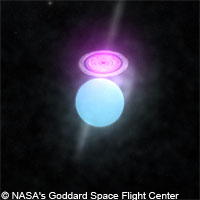Fermi telescope unlocks microquasar mystery
NASA's Fermi Gamma-ray Space Telescope successfully made the first clear detection of high-energy gamma-rays from Cygnus X-3, one of the stronger binary systems in the sky. Located some 37,000 light years away, Cygnus X-3 pairs a hot, massive star with a compact object that blasts twin radio-emitting jets of matter into space at the speed of light. The findings will offer scientists new insight into the acceleration and movement of high-energy particles. The research, published in the journal Science, is part of the 'GAMMARAYBINARIES' project, which received almost EUR 750,000 in funding under the Ideas Theme of the EU's Seventh Framework Programme (FP7). The binary systems are called microquasars: they are similar to tiny versions of distant galaxies (i.e. quasars). Experts speculate that these galaxies have emissions that are powered by huge black holes. 'Cygnus X-3 is a genuine microquasar and it's the first for which we can prove high-energy gamma-ray emission,' explained Dr Stephane Corbel of the Paris Diderot University in France, one of the authors of the study. The study showed that 'the gamma-ray emission probably originates from within the binary system, opening new areas in which to study the formation of relativistic jets'. Astronomers first detected the system in 1966, as being one of the sky's strongest X-ray sources. Cygnus X-3 also hit headlines in 1972 thanks to a radio frequency outburst that increased its radio frequency emissions a thousandfold. Scientists say it has had periodic radio outbursts at regular 367-day periods. Astronomers first claimed Cygnus X-3 as one of the first gamma-ray sources. Because of these observations, researchers were compelled to develop and improve gamma-ray detectors; the end result is the Large Area Telescope (LAT) aboard Fermi. According to the study's researchers, a huge Wolf-Rayet star is located at the centre of Cygnus X-3. Wolf-Rayet stars are hot massive luminous stars with temperatures ranging between 25 000 kelvin to 50 000 kelvin. This heat results in the star's mass 'bleeding' into space in a form that astronomers call 'stellar wind'. 'In just 100,000 years, this fast, dense wind removes as much mass from the Wolf-Rayet star as our Sun contains,' said Dr Robin Corbet of the University of Maryland in the US. A compact companion embedded in a disk of hot gas wheels around the star, Dr Corbet pointed out, adding that 'this object is most likely a black hole, but we can't yet rule out a neutron star'. The LAT identified changes in Cygnus X-3's gamma-ray output related to the companion's 4.8-hour orbital motion. The researchers discovered that the brightest gamma-ray emission occurs when the disk is on the far side of its orbit. 'This suggests that the gamma rays arise from interactions between rapidly moving electrons above and below the disk and the star's ultraviolet light,' Dr Corbel said. Ultraviolet photons gain energy and develop into gamma rays when the photons hit particles moving at a significant fraction of the speed of light. 'The process works best when an energetic electron already heading towards Earth suffers a head-on collision with an ultraviolet photon,' explained Dr Guillaume Dubus from France's Laboratory for Astrophysics. 'And this occurs most often when the disk is on the far side of this orbit.' French, German, Italian, Japanese, Swedish and US researchers contributed to this study. The GAMMARAYBINARIES ('Exploring the gamma-ray sky: binaries, microquasars and their impact on understanding particle acceleration, relativistic winds and accretion/ejection phenomena in cosmic sources') project is coordinated by Université Joseph Fourier Grenoble 1 in France. GAMMARAYBINARIES was launched in 2008 and is scheduled to end in 2013.
Countries
Germany, France, Italy, Japan, Sweden, United States



